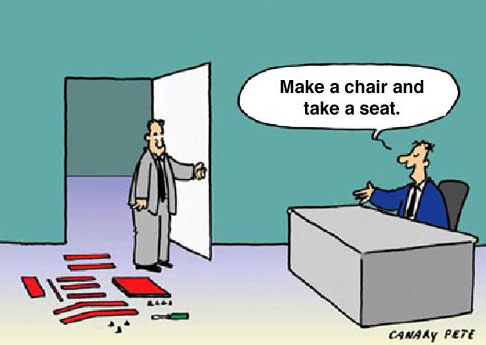If you have ever said, “Now remind me again…why did we hire that guy?” you know what it’s like to make a hiring mistake.
Talent mistakes are costly: replacing a minimum wage worker costs about $7500 and hiring a manager costs about the same as the annual salary! Really – contact me for a detailed hiring cost calculator.
Most managers don’t want to make a talent mistake, but it is hard to avoid when they use the standard “post-job-read-resumes-interview” hiring process. That’s because more than 50% of resumes contain erroneous information (enhancements or lies) and hiring decisions based on interviews have about the same success rate as flipping a coin! No wonder that 50% of companies and employees regret their hiring and job decisions!
Hiring is hard – no way around it, so quit looking for that killer interview question. Even Google figured out that those cute questions about manhole covers provided no useable data about the candidate. Let’s take a look at hiring from the manager’s point of view and see what should be fixed.
Stop and think about a time you hired someone who didn’t work out. How did you end up hiring the wrong person? When 166 managers were asked this question, 81% said their mistakes were made because their hiring process was not rigorous enough! Only 19% said the mistake could be blamed on the applicant.
Talent mistakes are costly: replacing a minimum wage worker costs about $7500 and hiring a manager costs about the same as the annual salary! Really – contact me for a detailed hiring cost calculator.
Most managers don’t want to make a talent mistake, but it is hard to avoid when they use the standard “post-job-read-resumes-interview” hiring process. That’s because more than 50% of resumes contain erroneous information (enhancements or lies) and hiring decisions based on interviews have about the same success rate as flipping a coin! No wonder that 50% of companies and employees regret their hiring and job decisions!
Hiring is hard – no way around it, so quit looking for that killer interview question. Even Google figured out that those cute questions about manhole covers provided no useable data about the candidate. Let’s take a look at hiring from the manager’s point of view and see what should be fixed.
Stop and think about a time you hired someone who didn’t work out. How did you end up hiring the wrong person? When 166 managers were asked this question, 81% said their mistakes were made because their hiring process was not rigorous enough! Only 19% said the mistake could be blamed on the applicant.
These four steps will improve your hiring process and help managers make better hiring decisions every time:
- Figure out what the job is. Few managers make the effort to clearly describe the job they are trying to fill. Instead they rely on a fly-by-the-seat-of-your-pants approach – the data above show how successful that is. Begin by asking: What work do we need to get done by the new employee? What does it look like when the employee is successful? Getting clear on the work and the results expected helps bring focus to the rest of the hiring process – document this in a clear job description.
- Test applicants. You know what the job is and now you have applicants. People lie on resumes and in the interview – they want the job so they “fake good” giving you answers they think you want. You know there are resume ghostwriters and interview coaches, too, right? So how can managers get a true picture of what the candidate can and can’t do? Give a test.
Start with one that gauges the match between the job requirements and work culture and the candidate’s personality and thinking style. These are called “pre-hire assessments” and the results are objective and accurate, reporting on the most critical characteristics of candidates – and you can’t see those on a resume or in an interview.
Once the assessment shows which candidates are the best match, give a short, job-related work assignment. Have a PR candidate write a press release or look at a programmer’s code. Refer to the job description you created in step one to figure out which assignment will help differentiate the top candidates. - Interview like you mean it! An interview should not be a conversation. It is another way to collect job-related candidate data. The best interviewers use behavioral interview questions for a preview of how the candidate will likely behave on the job.
Behavioral interview questions ask candidates to describe how they have handled a job-related situation in the past. Take this typical question, “Tell me how you would handle several projects at one time.” We all know how to answer that question. But if you want good information, turn it info a behavioral question: “This job requires the employee to manage several projects at the same time. Tell me about a time when you had to complete multiple assignments in the same time period. How did you handle the situation? Please be specific about the number of assignments, the actions you took, and the results.” - Plan a great new-hire experience. Once the manager makes hire, be sure the new employee starts to feel attached to the company on day one. Employees are more productive when they have good working relationships with their managers, when they feel valued, and when they understand how their work contributes to the success of the company. If the manager doesn’t provide good job orientation and initial training, all the hard work of hiring the best may be lost as the new employee starts eyeing the exit sign.
In the end, using a structured hiring process means high quality employees, better productivity, and a growing bottom line. Good hiring processes are seriously effective and the best part is these four steps are practically free!





